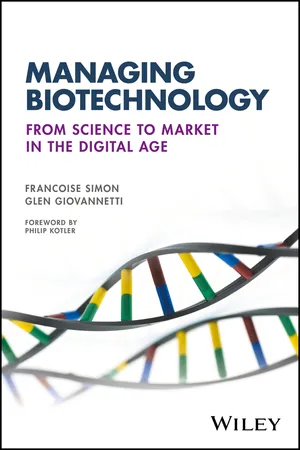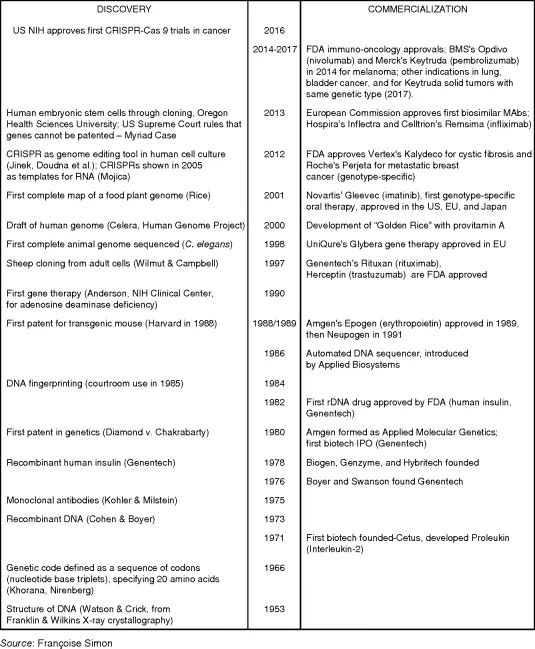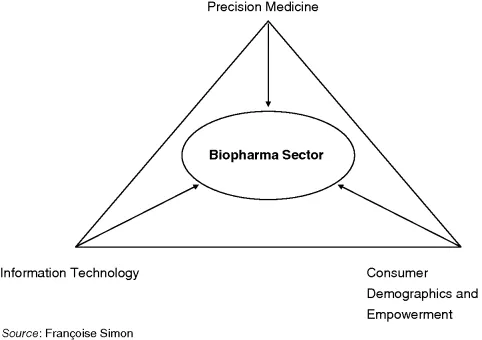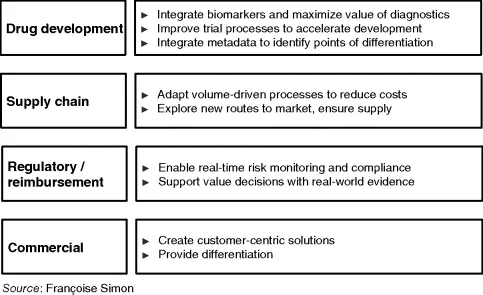
Managing Biotechnology
From Science to Market in the Digital Age
- English
- ePUB (mobile friendly)
- Available on iOS & Android
About this book
A comprehensive overview of the new business context for biopharma companies, featuring numerous case studies and state-of-the-art marketing models
Biotechnology has developed into a key innovation driver especially in the field of human healthcare. But as the biopharma industry continues to grow and expand its reach, development costs are colliding with aging demographics and cost-containment policies of private and public payers. Concurrently, the development and increased affordability of sophisticated digital technologies has fundamentally altered many industries including healthcare. The arrival of new information technology (infotech) companies on the healthcare scene presents both opportunities and challenges for the biopharma business model. To capitalize on new digital technologies from R&D through commercialization requires industry leaders to adopt new business models, develop new digital and data capabilities, and partner with innovators and payers worldwide.
Written by two experts, both of whom have had decades of experience in the field, this book provides a comprehensive overview of the new business context and marketing models for biotech companies. Informed by extensive input by senior biotech executives and leading consultancies serving the industry, it analyzes the strategies and key success factors for the financing, development, and commercialization of novel therapeutic products, including strategies for engagement with patients, physicians and healthcare payers. Throughout case studies provide researchers, corporate marketers, senior managers, consultants, financial analysts, and other professionals involved in the biotech sector with insights, ideas, and models.
JACQUALYN FOUSE, PhD, RETIRED PRESIDENT AND CHIEF OPERATING OFFICER, CELGENE
"Biotech companies have long been innovators, using the latest technologies to enable cutting edge science to help patients with serious diseases. This book is essential to help biotech firms understand how they can–and must–apply the newest technologies including disruptive ones, alongside science, to innovate and bring new value to the healthcare system."
BRUCE DARROW, MD, PhD, CHIEF MEDICAL INFORMATION OFFICER, MOUNT SINAI HEALTH SYSTEM
"Simon and Giovannetti have written an essential user's manual explaining the complicated interplay of the patients who deserve cutting-edge medical care, the biotechnology companies (big and small) creating the breakthroughs, and the healthcare organizations and clinicians who bridge those worlds."
EMMANUEL BLIN, FORMER CHIEF STRATEGY OFFICER AND SENIOR VICE PRESIDENT, BRISTOL-MYERS SQUIBB
"If you want to know where biopharma is going, read this book! Our industry is facing unprecedented opportunities driven by major scientific breakthroughs, while transforming itself to address accelerated landscape changes driven by digital revolutions and the emergence of value-based healthcare worldwide. In this ever-changing context, we all need to focus everything we do on the patients. They are why we exist as an industry, and this is ultimately what this insightful essay is really about."
JOHN MARAGANORE, PRESIDENT AND CHIEF EXECUTIVE OFFICER, ALNYLAM PHARMACEUTICALS
"Since the mapping of the human genome was completed nearly 15 years ago, the biotechnology industry has led the rapid translation of raw science to today's innovative medicines. However, the work does not stop in the lab. Delivering these novel medicines to patients is a complex and multifaceted process, which is elegantly described in this new book."
Frequently asked questions
- Essential is ideal for learners and professionals who enjoy exploring a wide range of subjects. Access the Essential Library with 800,000+ trusted titles and best-sellers across business, personal growth, and the humanities. Includes unlimited reading time and Standard Read Aloud voice.
- Complete: Perfect for advanced learners and researchers needing full, unrestricted access. Unlock 1.4M+ books across hundreds of subjects, including academic and specialized titles. The Complete Plan also includes advanced features like Premium Read Aloud and Research Assistant.
Please note we cannot support devices running on iOS 13 and Android 7 or earlier. Learn more about using the app.
Information
Part 1
New Models for Networked Innovation
Chapter 1
Digital Evolution of Biotechnology

Industry Applications
- In healthcare, red biotech has led to novel biologic therapeutics, including recombinant proteins such as insulin and growth hormone, monoclonal antibodies such as Genentech's Herceptin (trastuzumab) for HER2-positive breast cancer, vaccines, molecular diagnostics, gene and stem cell therapy, tissue engineering, and regenerative medicine.
- In food and agriculture, green biotech has improved crop efficiency and used bioremediation for environmental reclamation. It has blurred the distinction between food and medicine, with the emergence of medical foods and innovations such as a strain of “golden rice” yielding provitamin A [3].
- Marine biology has led to blue biotech, with food products and ingredients derived from algae, invertebrates, and fish; diagnostic agents such as fluorescent reporter protein; and marine extract additives in cosmetics.
- In industrial processes, white biotechnology has produced biodegradable plastics, renewable chemicals, pollution-eating bacteria, and advanced biofuels [4].

Impact of Megatrends

Digital Health Opportunities
- In R & D, digital health can optimize diagnostics through integrated biomarkers, increase speed to market, and streamline data analytics.
- In manufacturing, digital technology can adapt processes to reduce costs.
- From a regulatory and reimbursement standpoint, it can enable real-time drug monitoring and support health economics dossiers with real-world evidence.
- At the commercial end, digital health can allow deep integration of the customer voice, from drug co-creation to postlaunch communications, and it can help collect real-world evidence to support economics dossiers (Figure 1-4).

Infotechnology Initiatives in Healthcare
Table of contents
- Cover
- Title Page
- Copyright
- Dedication
- Foreword
- Preface
- Acknowledgments
- About the Authors
- Part 1: New Models for Networked Innovation
- Part 2: New Business and Marketing Models
- Part 3: New Models for Digital Health
- Conclusion
- References
- Index
- End User License Agreement